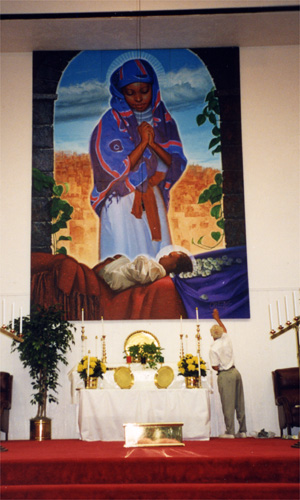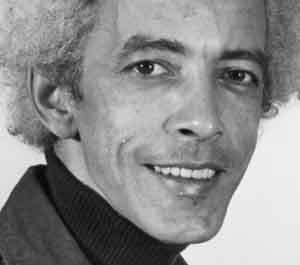| |
As a child growing up in Detroit, I was oblivious to my father's career as an artist. As long as he picked me up on Saturday morning and gave me paper to draw on I was happy. Like him, I began to draw when I was very young. I took great pleasure in it. You might say that my art career began in the sixth grade when I traded little drawings of nude women for extra desserts and cartons of chocolate milk in the lunchroom. Life was good.
As a teenager I sensed that there was something special about Carl Owens. I remember being a bit puzzled when my teachers, who had never met my father, seemed to know who he was. Carl Owens' home also served as his studio and gallery. It was full of art, supplies, equipment and strange objects and I loved it there. I marvelled as I watched him complete artwork for the Anheuser Busch "Great Kings of Africa" ads and other prominent illustrations. He encouraged me to pursue my own artwork. Still, Carl Owens life centered around his work and my life centered around my growing pains and special projects, such as bewildering my mother and finding creative ways to torment my younger brother.
Fast-forward to the late seventies: Doors long closed to deserving people of color were slowly creeping open. To many of his peers, Carl Owens was living proof that it was now possible for an African-American artist to make a living as an illustrator dealing directly with Fortune 500 clients. Also, he bypassed galleries and sold his fine art directly to a growing base of middle-class African-Americans many of whom were buying art for the first time. As a young adult I knew that Carl Owens was a playing a substantive role in the forward movement of African-Americans. I was proud of him but didn't say the words. I was entirely focused on my degree and budding career. Moreover, I was following that curious path that led from my African-American upbringing to an enticing new suburban life in a primarily white setting in central Florida.
As a grown man I would return home to Detroit until it wasn't home anymore. I had succeeded in escaping the violence that plagued the city but had unwittingly escaped my own culture. Carl Owens said that I had forgotten my roots, and it was true.
In the 90's I tried hard to "make up for lost time" with my father and discovered that it just was not possible. Still, we had a great time. Now that he is gone I can't help but think of our relationship as a half-finished painting, but in the words of Tony Soprano, "what are you gonna do?"
Carl Owens was an excellent example of someone who knew from an early age exactly why he was here. That kind of certainty added clarity to his life. From his point of view, he was here to make art not meet the expectations of others. I have no memory of him ever saying or doing anything that even remotely resembled self-doubt. To him, life was all about controlling the direction he moved in. He sought to simplify his life, reduce its' bulk, build it for speed and travel light. As he got older, he put limits on the number of hours he would work and with the exception of his Jaguar XJ8, curbed the desire for material possessions. He made a point of travelling abroad on a regular basis and reached out to younger African-American artists. Carl Owens collected the art of young artists that he wanted to encourage instead of the art of his peers. The older he grew, the more he smiled and the more he respected time. His goal: To have more disposable time and to enjoy the passage of time.
Someone famous said "In the end all you have are the people who love you and the work you leave behind." The people who loved him made sure he knew it. The work Carl Owens left behind will be organized into a digital book about his life and times now in writing to be released in several months. Until then, I offer you a reprint of Carl Owens biography below. Enjoy. |
 |
"Black Madonna" by Carl Owens
Acrylic on wood
Commissioned by the Shrine of the Black Madonna,
Atlanta, GA. |
 |
Carl Owens
1929-2002 |
Carl Owens professional experience in the field of Art began as an illustrator in the U.S. Army. Following this, he taught art in the Detroit Public Schools and later served as staff artist for the school system. He became a self-employed artist in 1968. He was a proud member of the National Conference of Artists (NCA), an organization of African-American artists established in Atlanta in 1959.
Included among Carl Owens many works are his paintings of King Affonso I, and King Khama in the "Great Kings of Africa" series for Anheuser Busch, Inc.; twentyfive "Soul of a Nation" drawings for the McDonald's Corporation; two displays - "Roots, Stems and Flowers" and "Ford Salutes the Black Composer" - which were exhibited nationally by the Ford Motor Company; the portrait series, "Ingenious Americans" for the National Distillers, Inc. two film-strips - "The Life of Frederick Douglass" and "The Negoes Quest for Education: - for the Pepsi Cola Company; a mural and book entitled "A Picture History of the Afro-American" for the Rand McNally Corporation; Illustrated the 1988 National Sickle Cell poster and the 1987 and 1988 calender of Black History for Aetna Life and Casualty. Other clients include Georgia Power, General Motors, Blue Cross-Blue Shield, The Michigan Chamber of Commerce, Motown Records Corp., Time Magazine, The Storer Broadcasting Co., Encyclopedia Britannica and Michcon.
Carl Owens began his career in portraiture. A sampling of the commissions he has received includes portraits of Former U.S. Solicitor General Wade McCree, Henry Ford II, Congressman John Conyers, Jr., Detroit Mayor Coleman Young, Mrs. Rosa Parks, Judge Damon Keith, Mr. Berry Gordy, Carman McRae and Reggie Jackson.
In addition to numerous private collections, Carl Owens fine art has been on exhibit at: The Whitney Museum of American Art, New York, The Minneapolis Institute of Arts, The Art Institute of Chicago, the M. H. DeYoung Museum, San Francisco, the Detroit Institute of Arts, the Cincinnati Art Museum, the Smithsonian Institute, Washington, D.C., the North American Black Historical Museum, Ontario Canada, the Museum of African-American History, Detroit, Michigan, the Sloan Museum, Flint, Michigan, and the Detroit Historical Museum. Carl Owens has exhibited in numerous galleries both nationally and internationally and his art is in the collections of the governments of Zimbabwe, Egypt, Grenada and Zambia.
Carl Owens and his art have been featured in a wide range of local and national publications including: The National Leader, Ebony, Essence, New York Society of Illustrators Annual, Art Director, Balalian News, News-week and U.S.A. today.
A partial list of honors awarded Carl Owens include: the New York Society of Illustrators Citation for Merit, Outstanding Artist Award, Michigan Chapter, National Conference of Artists, both a Testimonial Resolution and a Spirit of Detroit Award from the Detroit City Council, the Mayor's Award of Merit, the American Black Artist Pioneer Award, the Optimist International Certificate of Appreciation For Community Service, the American Black Artist Award for Outstanding Achievement in the Visual Arts, The National Conference of Artists First Afrikan World Festival Award, Visual Arts, and a Testimonial Resolution from James J. Blanchard, Governor of the State of Michigan. He was recipient of the 1983 Creative Artists grant from the Michigan Council of the Arts.
Carl Owens traveled abroad with other African-American artists to meet their counterparts in Latin America and Africa. His travels took him to The Second World Festival of Black and African Art and Culture, Lagos, Nigeria, The First New World Cultural Festival of the African Diaspora, Bahia and Rio De Janeiro, Brazil, The Second New World Cultural Festival of the African Diaspora, Port-Au-Prince, Haiti. Drawing and Painting trips have been taken to Egypt, West Africa, Greece, Turkey, Mexico and the Caribbean.
In the early 90's Carl Owens relocated to Atlanta. Eventually, he held regular "life drawing" classes during the evening in his studio with other African-American artists. The informal class grew to become an important monthly experience that now continues at Spelman College.
Carl Owens died December 11, 2002. He is survived by his two sons Duane and Brian R. Owens, a professional sculptor and painter with a studio based near Orlando, Florida. |
| Back to Home Page I Back to Previous Page I Back to Top |
Brian R. Owens
(T) 386-956-1724
© 2004 Brian R. Owens |
|
brianowensart.com |
(T)386-956-1724 |
|

